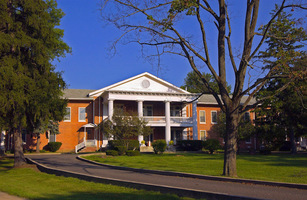 | Back to e-WV
| Back to e-WV
 The West Virginia Encyclopedia
The West Virginia Encyclopedia
 | Back to e-WV
| Back to e-WV
 The West Virginia Encyclopedia
The West Virginia Encyclopedia

After receiving a property donation from the Literary Society of Romney, the West Virginia Schools for the Deaf and the Blind, established by the legislature in 1870, opened in Romney in September of that year.
At first, many felt that one institution serving both the visually and hearing impaired was inappropriate; nonetheless, the two schools have co-existed from the beginning. Then named the West Virginia Institution for the Deaf and Dumb and Blind, the first year saw an enrollment of 25 deaf and five blind students. The enrollment grew steadily. In 1934, the first class of the deaf-blind was taught. Helen Keller, America’s most famous champion of the deaf-blind, visited the school. Today the state school serves many children with multiple handicaps.
The Romney school has long advocated for the rights of the disabled. Founder Howard H. Johnson fought for benefits, including free transmission through the mails of reading material for the blind, and free transportation to and from school for the pupils, at one time via a special B&O train.
The school has been a leader in teaching methodology. Early on, deaf children were taught both lip reading and sign language, some educators believing that lip reading skills would help prepare youth to function in a hearing society. The present holistic approach, known as total communication, combines speech with sign language. Computer technology simplifies the access of print and audio-visual information for the blind and deaf. The institution’s libraries provide learning materials for visually and hearing impaired individuals of all ages throughout the state.
The Romney school is an important historical site. The columned administration building, erected in 1846, originally housed the Romney Classical Institute. Other buildings date back to 1872. Later additions included a barn, bakery, gymnasium, and athletic fields. A hospital proved vital during two influenza epidemics, first during 1918 and again in 1922.
Medical advances have brought a decline in the school’s traditional population. Antibiotics and immunizations against measles have greatly reduced non-congenital causes of blindness and deafness. The decline of residential students is also explained by the advent of special education programs in local public schools and the Americans with Disabilities Act which mandates access to educational and career opportunities for all disabled persons, wherever they reside. The 2022 enrollment was 79 students, most of whom reside at the institution.
In 2021, the two schools merged into one institution while keeping the plural name. On February 26, 2022, the administration building was destroyed by an early morning fire.
West Virginia Schools for the Deaf and the Blind website
Written by Ann Warner
Brannon, Seldon. History of the West Virginia Schools for the Deaf & Blind 1870-1970. Romney: West Virginia Schools for the Deaf & Blind, 1970.